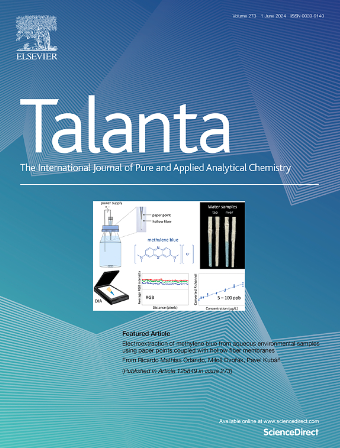光电位测定法:使用涂有含有石墨碳氮化光催化剂的本质微孔多胺薄膜的ph探针来检测糖
IF 5.6
1区 化学
Q1 CHEMISTRY, ANALYTICAL
引用次数: 0
摘要
在概念验证水平上,葡萄糖(或更普遍的碳水化合物)的光化学转化可以作为局部pH变化进行分析检测。利用传统的电位pH探针,开发了一种微孔涂层,用于在200-800 μM浓度范围内基于光诱导的局部pH变化来探测碳水化合物。光响应膜是基于纤维纤维素(以帮助渗透),光催化石墨氮化碳(g-C3N4)和本质微孔多胺宿主(PIM-EA-TB,作为反应环境和粘合剂)。薄膜修饰的pH-探针在ph4缓冲液(含邻苯二甲酸酯缓冲液)中进行预处理。当浸入水溶液时,打开蓝色LED (λ = 385 nm,约为。60mw cm−2)导致pH值瞬变为碱性,这与碳水化合物浓度相关(所有三种葡萄糖,果糖或蔗糖给出非常相似的信号)。LOD一般为70 μmol dm−3,线性范围可达800 μmol dm−3。超过800 μmol dm−3的非线性初步归因于有限的氧可用性。在ph探针表面的氧耗尽(引起碱性漂移)引起的光活性膜中质子的竞争产生和消耗,讨论了光电分析机制。本文章由计算机程序翻译,如有差异,请以英文原文为准。

Photo-potentiometry: Sensing of sugars using a pH-probe coated with a film of intrinsically microporous polyamine containing graphitic carbon nitride photocatalyst
At proof-of-concept level, the photochemical transformation of glucose (or more generally of carbohydrates) can be detected analytically as a localised pH change. Using a conventional potentiometric pH-probe, a microporous coating is developed to explore carbohydrate sensing in the 200–800 μM concentration range based on localised pH changes induced by light. The photo-responsive film is based on fibrous cellulose (to aid permeability), photocatalytic graphitic carbon nitride (g-C3N4), and an intrinsically microporous polyamine host (PIM-EA-TB, as reaction environment and binder). The film-modified pH-probe is pre-conditioned in a pH 4 buffer (containing phthalate buffer). When immersed in an aqueous solution, switching on a blue LED (λ = 385 nm, approx. 60 mW cm−2) causes a pH transient towards alkaline, which is correlated with the carbohydrate concentration (all three glucose, fructose, or sucrose give very similar signals). The LOD is typically 70 μmol dm−3, with a linear range up to 800 μmol dm−3. Non-linearity beyond 800 μmol dm−3 is tentatively attributed to limited oxygen availability. The photo-electroanalytical mechanism is discussed in terms of competing proton generation and consumption in the photoactive film linked to oxygen depletion (causing alkaline drift) at the pH-probe surface.
求助全文
通过发布文献求助,成功后即可免费获取论文全文。
去求助
来源期刊

Talanta
化学-分析化学
CiteScore
12.30
自引率
4.90%
发文量
861
审稿时长
29 days
期刊介绍:
Talanta provides a forum for the publication of original research papers, short communications, and critical reviews in all branches of pure and applied analytical chemistry. Papers are evaluated based on established guidelines, including the fundamental nature of the study, scientific novelty, substantial improvement or advantage over existing technology or methods, and demonstrated analytical applicability. Original research papers on fundamental studies, and on novel sensor and instrumentation developments, are encouraged. Novel or improved applications in areas such as clinical and biological chemistry, environmental analysis, geochemistry, materials science and engineering, and analytical platforms for omics development are welcome.
Analytical performance of methods should be determined, including interference and matrix effects, and methods should be validated by comparison with a standard method, or analysis of a certified reference material. Simple spiking recoveries may not be sufficient. The developed method should especially comprise information on selectivity, sensitivity, detection limits, accuracy, and reliability. However, applying official validation or robustness studies to a routine method or technique does not necessarily constitute novelty. Proper statistical treatment of the data should be provided. Relevant literature should be cited, including related publications by the authors, and authors should discuss how their proposed methodology compares with previously reported methods.
 求助内容:
求助内容: 应助结果提醒方式:
应助结果提醒方式:


